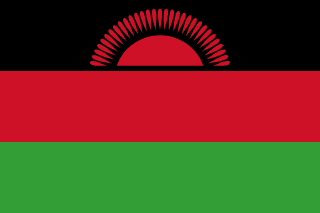Malawi - Geography

Here, let us take a look at the Geography of Malawi. Landlocked; Lake Nyasa, some 580 km long, is the country's most prominent physical feature; it contains more fish species than any other lake on earth. Mother's mean age at first birth is 19.1 years (2015/16 est.) (Note: data represents median age at first birth among women 20-49), whereas, the Maternal mortality ratio is 381 deaths/100,000 live births (2020 est.)
Geographical data of Malawi
| Location | Southern Africa, east of Zambia, west and north of Mozambique |
|---|---|
| Geographic coordinates | 13 30 S, 34 00 E |
| Map references | Africa |
| Tarrain | narrow elongated plateau with rolling plains, rounded hills, some mountains |
| Natural Resources | limestone, arable land, hydropower, unexploited deposits of uranium, coal, and bauxite |
| Natural Hazards | flooding; droughts; earthquakes |
| Irrigated Land | 740 sq km (2012) |
| Major rivers (by length in km) | Zambezi (shared with Zambia [s], Angola, Zimbabwe, Namibia, Tanzania, and Mozambique [m]) - 2,740 km note – [s] after country name indicates river source; [m] after country name indicates river mouth |
| Major aquifers | |
| Land Boundaries | 2,857 km |
| Border Countries | Mozambique 1,498 km; Tanzania 512 km; Zambia 847 km |
| Coastline | 0 km (landlocked) |
| Climate | sub-tropical; rainy season (November to May); dry season (May to November) |
| Area | |
| Total Area | |
| Land Area | 94,080 sq km |
| Water Area | 24,404 sq km |
| comparative Area | slightly smaller than Pennsylvania |
| Maritime Claims | |
| Elevations | |
| Highest point | Sapitwa (Mount Mlanje) 3,002 m |
| Lowest point | junction of the Shire River and international boundary with Mozambique 37 m |
| Mean elevation | 779 m |
| Land Use | |
| Agricultural land | 64.2% (2022 est.) |
| Agricultural land: arable land | arable land: 42.4% (2022 est.) |
| Agricultural land: permanent crops | permanent crops: 2.1% (2022 est.) |
| Agricultural land: permanent pasture | permanent pasture: 19.6% (2022 est.) |
| Forest | 22.9% (2022 est.) |
| Other | 12.9% (2022 est.) |
Population Distribution
Population density is highest south of Lake Nyasa as shown in this population distribution map
People and Society
In Malawi, the different Ethnic groups are such that we have: Chewa 34.3%, Lomwe 18.8%, Yao 13.2%, Ngoni 10.4%, Tumbuka 9.2%, Sena 3.8%, Mang'anja 3.2%, Tonga 1.8%, Nyanja 1.8%, Nkhonde 1%, other 2.2%, foreign 0.3% (2018 est.)
| Population | |
|---|---|
| Pop growth rate | 2.22% (2024 est.) |
| Birth rate | 26.6 births/1,000 population (2024 est.) |
| Death rate | 4.5 deaths/1,000 population (2024 est.) |
| Health expenditure | 7.4% of GDP (2021) |
| Physicians Density | |
| Hospital bed Density | 1.3 beds/1,000 population (2011) |
| Total fertility rate | 3.19 children born/woman (2024 est.) |
| Gross reproduction rate | 1.58 (2024 est.) |
| Contraceptive prevalence rate | 65.6% (2019/20) |
| Est married women (ages 15-49) | 60.7% (2022 est.) |
| Literacy | age 15 and over can read and write |
| Education expenditures | 2.9% of GDP (2020 est.) |
| Net Migration rate | 0 migrant(s)/1,000 population (2024 est.) |
| Nationality | Malawian | Malawian(s) |
| Languages | English (official), Chewa (dominant), Lambya, Lomwe, Ngoni, Nkhonde, Nyakyusa, Nyanja, Sena, Tonga, Tumbuka, Yao |
| Religions | Protestant 33.5% (includes Church of Central Africa Presbyterian 14.2%, Seventh Day Adventist/Baptist 9.4%, Pentecostal 7.6%, Anglican 2.3%), Roman Catholic 17.2%, other Christian 26.6%, Muslim 13.8%, traditionalist 1.1%, other 5.6%, none 2.1% (2018 est.) |
| Age Structure | |
| 0-14 years | 37.7% (male 4,080,567/female 4,132,710) |
| 15-64 years | 58.4% (male 6,217,761/female 6,487,273) |
| 65 years and over | 3.9% (2024 est.) (male 376,266/female 468,732) |
| Dependency Ratios | |
| Total dependency ratio | 84.7 |
| Youth dependency ratio | 79.7 |
| Elderly dependency ratio | 5 |
| Potential support ratio | 20.1 (2021 est.) |
| Median Age | |
| Total | 20.3 years (2024 est.) |
| Male | 20 years |
| Female | 20.6 years |
| Urbanization | |
| Urban population | 18.3% of total population (2023) |
| Rate of urbanization | 4.41% annual rate of change (2020-25 est.) |
| Major urban areas (Pop) | 1.276 million LILONGWE (capital), 1.031 million Blantyre-Limbe (2023). |
| Sex Ratio | |
| At birth | 1.01 male(s)/female |
| 0-14 years | 0.99 male(s)/female |
| 15-64 years | 0.96 male(s)/female |
| 65 years and over | 0.8 male(s)/female |
| Total population | 0.96 male(s)/female (2024 est.) |
| Infant Motality | |
| Total | 31.9 deaths/1,000 live births (2024 est.) |
| Male | 36.4 deaths/1,000 live births |
| Female | 27.4 deaths/1,000 live births |
| Life Expectancy at birth | |
| Total population | 73 years (2024 est.) |
| Male | 69.9 years |
| Female | 76.1 years |
| Drinking Water Sources | |
| Improved: urban | urban: 96.7% of population |
| Improved: rural | rural: 91% of population |
| Improved: total | total: 92% of population |
| Unimproved: urban | urban: 3.3% of population |
| Unimproved: rural | rural: 9% of population |
| Unimproved: total | total: 8% of population (2020 est.) |
| Sanitation facility acess | |
| Improved: urban | urban: 59.9% of population |
| Improved: rural | rural: 35.9% of population |
| Improved: total | total: 40% of population |
| Unimproved: urban | urban: 40.1% of population |
| Unimproved: rural | rural: 64.1% of population |
| Unimproved: total | total: 60% of population (2020 est.) |
| Alcohol consumption per capita | |
| Total | 2.04 liters of pure alcohol (2019 est.) |
| Beer | 0.08 liters of pure alcohol (2019 est.) |
| Wine | 0 liters of pure alcohol (2019 est.) |
| Spirits | 0.25 liters of pure alcohol (2019 est.) |
| Other alcohols | 1.7 liters of pure alcohol (2019 est.) |
| Tobacco use | |
| Total | 10.8% (2020 est.) |
| Male | 17.5% (2020 est.) |
| Female | 4.1% (2020 est.) |
| Child marriage | |
| Women married by age 15 | 7.5% |
| Women married by age 18 | 37.7% |
| Men married by age 18 | 7% (2020 est.) |
Demographic profile
All Important Facts about Malawi
Want to know more about Malawi? Check all different factbooks for Malawi below.









